The Number of Men Getting Plastic Surgery is Rising

By:
The cosmetic surgery industry is booming. People in the U.S. spend billions of dollars a year on cosmetic procedures, from breast augmentation, facelifts and liposuction to butt implants, Botox injections and more.
In 2014, doctors performed about 15.6 million cosmetic procedures, according to a report by the American Society of Plastic Surgeons. That's a three percent increase compared to the previous year, and more than twice the number of procedures reported in 2000, numbers show. It's obvious more and more Americans are opting for procedures to alter their physical appearance.
And it's not just women, there's a steady increase of men getting cosmetic procedures to augment their appearance.
Men getting "work" done.
Women comprise the vast majority of people who opt for plastic surgery and cosmetic procedures, accounting for 92 percent of all operations in 2014. But the 1.26 million procedures performed on men last year is nearly 25 percent higher compared to fifteen years ago. Most of the increase can be attributed to men getting procedures like Botox and other minimally invasive operations.
 Guy with the camera - flic.krGuy with the camera - flic.kr
Guy with the camera - flic.krGuy with the camera - flic.kr
Men underwent about 1 million minimally invasive cosmetic procedures last year, a nearly 70 percent increase compared to 2000, according to statistics from the American Society of Plastic Surgeons. The procedures typically don't come with serious scars or lengthy recovery periods, which Michigan-based plastic surgeon Dr. Anthony Youn, a regular on the Rachael Ray Show, explained to ATTN: lessens the stigma associated with cosmetic procedures for men, who can have clandestine work done.
"Men can have work done without looking like an overdone '80s actor," Youn said. "Botox is king for men."
While the total number of serious surgical procedures men get has decreased since 2000, Youn said a lot of men are choosing to get pectoral implants and breast reductions. About 1,054 implant procedures were executed last year, an increase of 208 percent compared to 2013, while there were 26,175 male breast reductions last year, an increase of 29 percent since 2000.
Why are men getting plastic surgery?
In 2014, Manhattan-based plastic surgeon Dr. Douglas Steinbrech told Business Insider that men get plastic surgery "to look good and stay competitive in the job market."
"Men get surgery as a key tool to help them succeed," Steinbrech said. "In a marketplace where looking fit, younger, and more masculine is imperative, the better you look, the better your chances of ascending the corporate ladder."
Steinbrech went on to characterize four types of men who commonly seek plastic surgery, and he detailed the procedures they favor.
The male model, who might get liposuction to define abdominal muscles, implants for pectorals and gluteals, along with defining the jawline. "You take an average, good-looking kid, and you enhance his jaw, elongate his chin, enhance his cheekbones, and suddenly he looks like the cover of Vogue," Dr. Steinbrech explained to Business insider.
Secondly, the body builder wants similar procedures to that of the male model—except the body builder wants to be bigger. "Big chest, big glutes, but muscularly defined," he stated in 2014. "They also have some of that fatty tissue around the breasts from steroids that we often remove as well."
The third type is the CEO or board member, who may want the "Forbes Facelift," according to Business Insider, which includes re-contouring the jawline, along with an eye and neck-lift. This procedure may leave some wrinkles to appear trustworthy. "Daddy do-overs" are the fourth general type of plastic surgery requested by men. "This is what the banker wants," Dr. Steinbrech said to Business Insider. "He's married with kids, probably put on 15 pounds. He's in his 40s and he's thinking, 'Man, I used to look so good in college.'"
The rise of technology.
Overall the rise of plastic surgery in both men and women has a lot to do with technology: There is a lot that doctors can do without a person going under the knife.
"The technology is so much better now that there are more ways to improve how you look without going under the knife," Dr. Youn explained.
Minimally-invasive cosmetic procedures increased 4 percent, with more than 13.9 million procedures in 2014, according to the American Society of Plastic Surgeons, which Youn serves as a spokesman of. Technology has allowed for the proliferation of procedures like soft tissue filler implants, microdermabrasion and chemical peels that can tighten and revitalize skin in ways that achieve some of the intended effect of a face lift.
Youn said it all started with Botulinum Toxin Type A injections (think Botox, Dysport, etc.) which are by far the most common cosmetic procedures. The injections inhibit muscular nerve signals in order to weaken muscles so they can't contract, according to the American Society of Plastic Surgeons. The procedure is supposed to reduce everything from thick creases in the neck to crows feet around eyes, frown lines and forehead creases, according to the group.
Here's a look at the top five minimally-invasive procedures in 2014 :
1. Botulinum Toxin Type A (6.7 million procedures)
2. Soft tissue fillers (2.3 million procedures)
3. Chemical peel (1.2 million procedures)
4. Laser hair removal (1.1 million procedures)
5. Microdermabrasion (881,905 procedures)
And here's a look at the top five surgical procedures in 2014:
1. Breast augmentation (286,254 procedures)
2. Nose reshaping (217,124 procedures)
3. Liposuction (210,552 procedures)
4. Eyelid surgery (206,509 procedures)
5. Facelift (128,266 procedures)
Source: the American Society of Plastic Surgeons
Social media, 'selfie' culture, and teens.
As ATTN: has pointed out before, plastic surgery is on the rise with teenagers. Studies have identified social media and "selfies" as fueling a surge in self-awareness that is landing more people in the plastic surgeons office asking for procedures like Botox, especially Millennials, according to the American Academy of Facial Plastic and Reconstructive Surgery . "What’s more," the trade group said in a news release, "the trend of using video clips instead of still images on social media is fueling more wrinkle-conscious consumers. Dynamic wrinkles that occur only when we are talking, smiling or laughing will be more visible to friends and fans."
Reuters reported on the trend and interviewed Dr. Sam Rizk, a plastic surgeon with a Manhattan practice who said more and more patients have been coming to him asking for surgeries inspired by their desire to make their selfie game strong. But he said "not everyone who requests surgery needs it because a selfie produces a distorted image that does not represent how a person really looks."
"We all will have something wrong with us on a selfie image," he explained. "I refuse a significant proportion of patients with selfies because I believe it is not a real image of what they actually look like in person."
The doctor added: "Too many selfies indicate a self obsession and a certain level of insecurity that most teenagers have. It just makes it worse...Now they can see themselves in 100 images a day on Facebook and Instagram."
Celebrity worship.
The American Academy of Facial Plastic and Reconstructive Surgery says that consumers "are more obsessed than ever with celebrities."
"We are constantly bombarded with celebrity images that have been photoshopped to perfection," said the release, "and as a result, more consumers want to look like their celebrity crushes." The organization surveyed 2,500 members last year looking for trends in the facial plastic surgery industry. They found that 13 percent of the doctors who responded saw an increase in requests for celebrity inspired procedures, an increase of three percent since 2013 and seven percent since 2012, according to the organization.
"So who was most wanted in 2014? Angelina Jolie’s lips and cheekbones came in first," according to a summary of the survey, followed by "Beyoncé’s facial structure, Kim Kardashian’s eyes and jawline, Brad Pitt’s nose, and Natalie Portman’s nose."
“Some people are attracted to the power, fame and attention that being a celebrity brings,” said Dr. Stephen S. Park, president of the AAFPRS, in a statement. “It’s important to remember that simply changing your appearance will not give you the same level of recognition. Celebrity photos are so often re-touched that their images are distorted which can result in unrealistic expectations that propel consumers to seek excessive or extreme surgeries.”
Risks of plastic surgery.
The Mayo Foundation for Medical Education and Research advises people thinking about getting cosmetic surgery to consider the "risks and limitations."
Before you proceed with cosmetic surgery, consider:
- Your expectations. Anticipate improvement, not perfection. If you expect cosmetic surgery to turn you into a movie star, you're bound to be disappointed. Don't count on surgery to save a rocky relationship, gain a promotion or improve your social life.
- Expense. Cosmetic surgery isn't covered by most health insurance plans. The cost varies depending on the procedure, ranging from hundreds to thousands of dollars. Also, consider the cost of any follow-up care or additional corrective procedures.
- Risks. Dissatisfaction is possible after any type of cosmetic surgery. Surgical complications are possible, too — including excessive bleeding or infection at the surgical site.
- Recovery. After cosmetic surgery, you might need days, weeks or even months to recover. Understand the physical effects that might be part of your recovery, as well as how the surgery might affect aspects of your personal and professional life.
- Psychological changes. Your self-esteem might improve after cosmetic surgery, but cosmetic surgery isn't likely to relieve depression or other mental health conditions.
Youn stressed that the cosmetic surgery industry needs more regulations to ensure that unqualified or negligent doctors are barred from procedures.
"Without more regulation," he said, "you'll continue to hear about the horror stories you see on shows like 'Botched.'"
